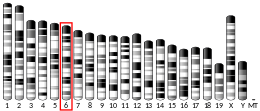TATA element modulatory factor is a protein that in humans is encoded by the TMF1 gene.[4][5]
Interactions
editTMF1 has been shown to interact with FER[6] and Androgen receptor.[7]
References
edit- ^ a b c GRCm38: Ensembl release 89: ENSMUSG00000030059 – Ensembl, May 2017
- ^ "Human PubMed Reference:". National Center for Biotechnology Information, U.S. National Library of Medicine.
- ^ "Mouse PubMed Reference:". National Center for Biotechnology Information, U.S. National Library of Medicine.
- ^ Garcia JA, Ou SH, Wu F, Lusis AJ, Sparkes RS, Gaynor RB (Nov 1992). "Cloning and chromosomal mapping of a human immunodeficiency virus 1 "TATA" element modulatory factor". Proc Natl Acad Sci U S A. 89 (20): 9372–6. Bibcode:1992PNAS...89.9372G. doi:10.1073/pnas.89.20.9372. PMC 50133. PMID 1409643.
- ^ "Entrez Gene: TMF1 TATA element modulatory factor 1".
- ^ Schwartz, Y; Ben-Dor I; Navon A; Motro B; Nir U (Sep 1998). "Tyrosine phosphorylation of the TATA element modulatory factor by the FER nuclear tyrosine kinases". FEBS Lett. 434 (3): 339–45. doi:10.1016/S0014-5793(98)01003-5. ISSN 0014-5793. PMID 9742951. S2CID 24338520.
- ^ Hsiao, P W; Chang C (Aug 1999). "Isolation and characterization of ARA160 as the first androgen receptor N-terminal-associated coactivator in human prostate cells". J. Biol. Chem. 274 (32): 22373–9. doi:10.1074/jbc.274.32.22373. ISSN 0021-9258. PMID 10428808.
Further reading
edit- Bonaldo MF, Lennon G, Soares MB (1997). "Normalization and subtraction: two approaches to facilitate gene discovery". Genome Res. 6 (9): 791–806. doi:10.1101/gr.6.9.791. PMID 8889548.
- Schwartz Y, Ben-Dor I, Navon A, et al. (1998). "Tyrosine phosphorylation of the TATA element modulatory factor by the FER nuclear tyrosine kinases". FEBS Lett. 434 (3): 339–45. doi:10.1016/S0014-5793(98)01003-5. PMID 9742951. S2CID 24338520.
- Hsiao PW, Chang C (1999). "Isolation and characterization of ARA160 as the first androgen receptor N-terminal-associated coactivator in human prostate cells". J. Biol. Chem. 274 (32): 22373–9. doi:10.1074/jbc.274.32.22373. PMID 10428808.
- Mori K, Kato H (2002). "A putative nuclear receptor coactivator (TMF/ARA160) associates with hbrm/hSNF2 alpha and BRG-1/hSNF2 beta and localizes in the Golgi apparatus". FEBS Lett. 520 (1–3): 127–32. doi:10.1016/S0014-5793(02)02803-X. PMID 12044884. S2CID 84784473.
- Zhang Y, Fondell JD, Wang Q, et al. (2002). "Repression of androgen receptor mediated transcription by the ErbB-3 binding protein, Ebp1". Oncogene. 21 (36): 5609–18. doi:10.1038/sj.onc.1205638. PMID 12165860. S2CID 22209143.
- Strausberg RL, Feingold EA, Grouse LH, et al. (2003). "Generation and initial analysis of more than 15,000 full-length human and mouse cDNA sequences". Proc. Natl. Acad. Sci. U.S.A. 99 (26): 16899–903. Bibcode:2002PNAS...9916899M. doi:10.1073/pnas.242603899. PMC 139241. PMID 12477932.
- Ota T, Suzuki Y, Nishikawa T, et al. (2004). "Complete sequencing and characterization of 21,243 full-length human cDNAs". Nat. Genet. 36 (1): 40–5. doi:10.1038/ng1285. PMID 14702039.
- Fridmann-Sirkis Y, Siniossoglou S, Pelham HR (2004). "TMF is a golgin that binds Rab6 and influences Golgi morphology". BMC Cell Biol. 5: 18. doi:10.1186/1471-2121-5-18. PMC 419336. PMID 15128430.
- Lim J, Hao T, Shaw C, et al. (2006). "A protein-protein interaction network for human inherited ataxias and disorders of Purkinje cell degeneration". Cell. 125 (4): 801–14. doi:10.1016/j.cell.2006.03.032. PMID 16713569. S2CID 13709685.
- Beausoleil SA, Villén J, Gerber SA, et al. (2006). "A probability-based approach for high-throughput protein phosphorylation analysis and site localization". Nat. Biotechnol. 24 (10): 1285–92. doi:10.1038/nbt1240. PMID 16964243. S2CID 14294292.
- Yamane J, Kubo A, Nakayama K, et al. (2007). "Functional involvement of TMF/ARA160 in Rab6-dependent retrograde membrane traffic" (PDF). Exp. Cell Res. 313 (16): 3472–85. doi:10.1016/j.yexcr.2007.07.010. hdl:2433/135781. PMID 17698061.


